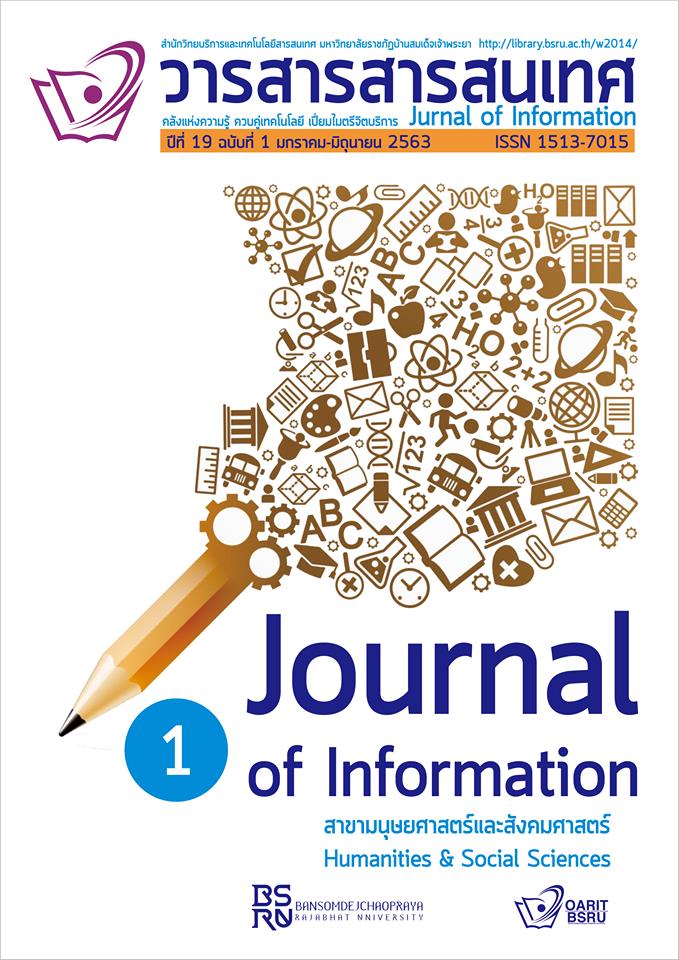The Evaluation of Information Studies Major Students s' Satisfaction toward Teaching and Learning Process by using Kahoot! Program
Keywords:
Evaluate satisfaction, Kahoot! applicationAbstract
The purpose of this research was to evaluate satisfaction of Information Studies students in learning process and the problems by using Kahoot! application. The sample used in this study consisted of 123 students majoring in Information Studies in Academic Year 2019 at Srinakharinwirot University. The research was designed to use questionnaire for data collection method. The result was analyzed by descriptive statistics, including frequency, percentage, mean, and standard deviation. The research found that the satisfaction of Information Studies students in using Kahoot! application for learning process was at the highest level. When considering each aspect, the satisfaction in area of enjoyment perspective and benefit from the application were ranked at the highest levels.The satisfaction in area of application usage was ranked at high level. Problems and Obstacles of Kahoot! application was ranked at high level.
References
กรุงเทพ. ใน การประชุมหาดใหญ่วิชาการระดับชาติและนานาชาติ ครั้งที่ 8 (น.72-82). สงขลา: มหาวิทยาลัยหาดใหญ่.
โชติมา วัฒนะ และคณะ. (ผู้ถ่ายภาพ). (2562). กรอบแนวคิดการวิจัย [ภาพถ่าย]. กรุงเทพฯ: สาขาวิชาสารสนเทศศึกษา คณะมนุษยศาสตร์ มหาวิทยาลัยศรีนครินทรวิโรฒ.
ฟาฏินา วงศ์เลขา. (2558). การจัดการเรียนการสอนในยุคโลกดิจิตอล. สืบค้น 3 พฤศจิกายน 2562,จาก https://www.dailynews.co.th/education/358284
รุจาภา เพชรเจริญ, และ วรสิทธิ์ เจริญศิลป์. (2560, กรกฏาคม-ธันวาคม). การประเมินการใช้ KAHOOT! Program ในการจัดการเรียนการสอนผ่านเครือข่ายการสอนทางไกล Telemedicine.
วารสารครุพิบูล, 5(2), 162-175.
วัลภา คงพัวะ. (2562, มกราคม-มิถุนายน). การศึกษาความพึงพอใจที่มีต่อการใช้ KAHOOT! ในการจัดการเรียนรู้ของนักศึกษาระดับปริญญาตรี สาขาวิชาการจัดการ มหาวิทยาลัยนอร์ทกรุงเทพ
ศูนย์การศึกษา นนทบุรี. วารสารวิชาการสมาคมสถาบันอุดมศึกษาเอกชนแห่งประเทศไทย, 25(1), 114-132.
ยืน ภู่วรวรรณ. (2559). เอกสารประกอบการบรรยายหัวข้อเรื่อง“รู้เท่าทันสื่อ รู้เท่าทันสารสนเทศหัวใจของการเรียนรู้ศตวรรษที่ 21”. สืบค้น 4 พฤศจิกายน 2562, จาก
https://www.nstda.or.th/nac/2016/index78d3.html?page_id=661
Fontaris, P., Mastoras, T., Leinfellner, R. and Rosunally, R. (2016). ‘Climbing up the Leaderboard: An Empirical Study of Applying Gamification Techniques to a
Computer Programming Class.’ Electronic Journal of e-learning. 14(2), 94-110.
Ismail, M. & Mohammad, J. A. (2017, January). Kahoot: A Promising Tool for Formative Assessment in Medical Education. Education in Medicine Journal, 9(2), 19-26.
Krejcie, R. V., & Morgan, D. W. (1970). Determining sample size for research activities. Educational and Psychological Measurement, 30(3), 607–610.
Licorish, S. A., George, J. L., Owen, H. E., & Daniel, B. (2017,December). “Go Kahoot!” enriching classroom engagement, motivation and learning experience with
games. In Proceedings of the 25th International Conference on Computers in Education, 755-764.
Plump, C.M., & La Rosa. J. (2017, February). Using Kahoot! in the Classroom to Create Engagement andActive Learning: A Game-Based Technology Solution for
eLearning Novices. Management Teaching Review, 2(2), 151-158.
Rosas, R., Nussbaum, M., Cumsille, P., Marianov, V., Correa, M., Flores, P., et al. (2003,
January). Beyond nintendo: Design and assessment of educational video games for first
and second grade students. Computers and Education, 40(1), 71–94.
Sabandar G N C, Supit N R. & Suryana E. (2018, December). Kahoot!: Bring the Fun Into the
Classroom!. IJIE (Indonesian J. Informatics Educ). 2,(2), 127-134.
Soward, S.W. (1997). Save the Time of the Surface Evaluating Web Site for Users. Library Hi Tech, 15(3-4), 155-158.
Wang, A. I. (2015, March). The wear out effect of a game-based student response system. Computers & Education, 82(3), 217-227.
Downloads
Published
How to Cite
Issue
Section
License
บทความ ข้อความ ภาพประกอบ และตารางประกอบที่ลงพิมพ์ในวารสารเป็นความคิดเห็นส่วนตัวของผู้นิพนธ์ กองบรรณาธิการไม่จำเป็นต้องเห็นตามเสมอไป และไม่มีส่วนรับผิดชอบใดๆ ถือเป็นความรับผิดชอบของผู้นิพนธ์เพียงผู้เดียว






